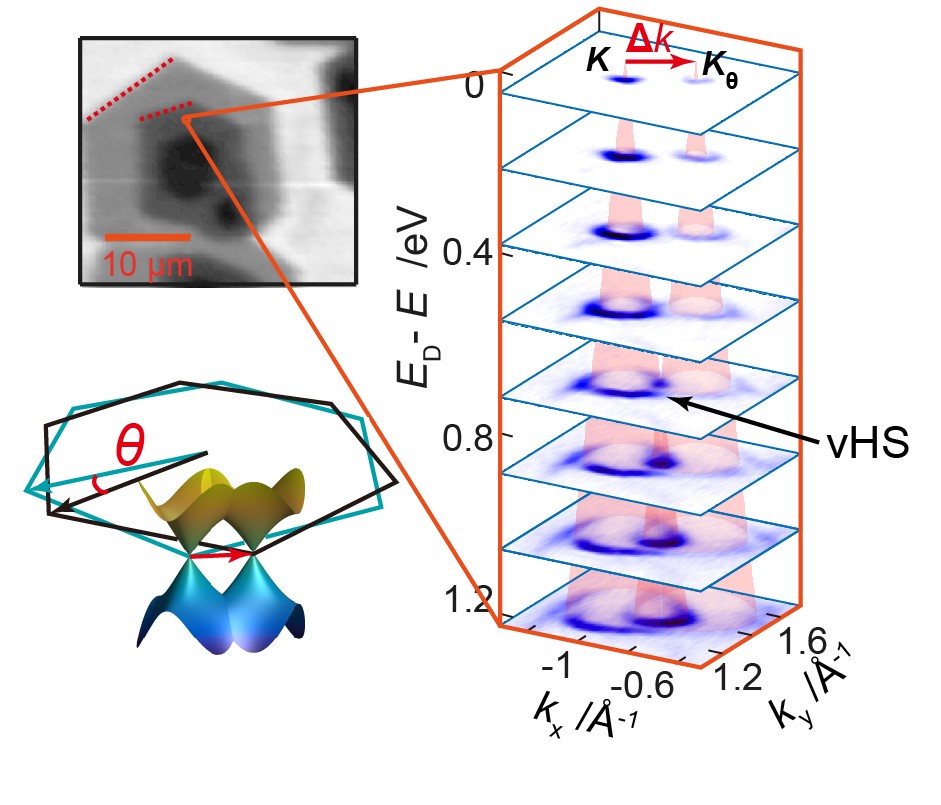Electronic structure of twisted few layer graphene

Microscopic Lego and Micro-ARPES
Stacking thin films together is just like playing ‘microscopic Lego’. The 2010 Nobel Prize in Physics is for finding the first building block: graphene. Ever since then, there have been more atomically thin materials coming out, such as silicene, germanene, boron nitride, etc. The interplay among these thin films can result in very different electronic properties. The different combination possibility and the stacking order provide a large parameter space to search (and to write papers about).
To make the electronic application with stacking thin film materials, one must answer the question: how does the electronic structure change in different stacking parameters? To answer this question, one may use Angular Resolved Photo-Emission Spectroscopy (ARPES) to visualize the energy band directly. However, the traditional ARPES use a millimeter-sized light spot to excite the electrons, which does not suit a typical several-micrometer-sized flake. The recent advances in ARPES with micrometer-resolution (micro-ARPES) provides a wonderful tool to solve this problem.
My work using micro-ARPES to study the twisted few layer graphene includes
- the Fermi level evolution with layer numbers in multilayer graphene on a substrate
- the electronic structure evolution with twist angle in twisted bilayer graphene
- the electronic structure of twisted trilayer graphene.
The results are concluded in our recent publication DOI: 10.1002/adma.201606741.
Modelling the Fermi level in a multilayer system
 Substrate is an important factor to consider when making any thin film device. One important feature about the metallic substrates is that they provide electrons and effectively ‘dope’ the thin films. Intuitively, the more number of layers covering on a substrate, the weaker this doping effect will be, since the underlying layers act as a shield. This intuition is in accordance with our observation shown above (Figures a and b). The Fermi level rises with the number of layers and reaches nearly neutral position when the number goes to five.
Substrate is an important factor to consider when making any thin film device. One important feature about the metallic substrates is that they provide electrons and effectively ‘dope’ the thin films. Intuitively, the more number of layers covering on a substrate, the weaker this doping effect will be, since the underlying layers act as a shield. This intuition is in accordance with our observation shown above (Figures a and b). The Fermi level rises with the number of layers and reaches nearly neutral position when the number goes to five.
To quantitatively explain this layer-dependent doping phenomenon, we propose a multilayer capacitor model (Figures c, d and e). The effective chemical potential causes an electric potential difference between the copper substrate and the graphene. This potential difference is then further tuned by an effective interlayer distance. With these two parameters to be fitted, our model explains the experiment data very well (Figure f). This model is discussed in full detail in the supplementary materials of DOI: 10.1002/adma.201606741.
Evolution of the band structure of twisted bilayer and more
 The driving parameters in the electronic structure in twisted bilayer graphene is the twist angle. As the angle changes between the two layers, the electronic structure will rotate accordingly. It turns out the rotational mismatch weakens the interaction of electrons of the two different layers. This causes the electronic structure of twisted bilayer graphene remain similar to that of a single layer. However, in the intersection point of the two bands, a gap is opened due to interlayer hybridization, resulting a special structure called van Hove Singularity (vHS). Will this interlayer coupling effect remain even the twist angle is large? How will the band evolve with the twist angle? Our results show that the vHS exists in large twist angle and the vHS energy level follows the prediction by simply considering the intersection position of two rotated single-layer graphene bands (Figure c).
The driving parameters in the electronic structure in twisted bilayer graphene is the twist angle. As the angle changes between the two layers, the electronic structure will rotate accordingly. It turns out the rotational mismatch weakens the interaction of electrons of the two different layers. This causes the electronic structure of twisted bilayer graphene remain similar to that of a single layer. However, in the intersection point of the two bands, a gap is opened due to interlayer hybridization, resulting a special structure called van Hove Singularity (vHS). Will this interlayer coupling effect remain even the twist angle is large? How will the band evolve with the twist angle? Our results show that the vHS exists in large twist angle and the vHS energy level follows the prediction by simply considering the intersection position of two rotated single-layer graphene bands (Figure c).
It turns out that the van Hove Singularity controls many properties in twisted bilayer graphene. The photocurrent sensitivity can be explained by the excitation of photons between the two van Hove Singularities (one below the Fermi surface and the other above the Fermi surface). A wavelength-selective photodector is fabricated with the twisted bilayer graphene by our collaborator as the sensitive wavelength can be tuned with the twist angle.
Related publications
- Peng, H., Schröter, N., Yin, J., Wang, H., Chung, T. F., Yang, H., … & Zhang, T. (2017). Substrate Doping Effect and Unusually Large Angle van Hove Singularity Evolution in Twisted Bi‐and Multilayer Graphene. Advanced Materials, 29(27).
- Yin, J., Wang, H., Peng, H., Tan, Z., Liao, L., Lin, L., … & Liu, Z. (2016). Selectively enhanced photocurrent generation in twisted bilayer graphene with van Hove singularity. Nature communications, 7, 10699.
- Liao, L., Wang, H., Peng, H., Yin, J., Koh, A. L., Chen, Y., … & Liu, Z. (2015). van Hove singularity enhanced photochemical reactivity of twisted bilayer graphene. Nano letters, 15(8), 5585-5589.